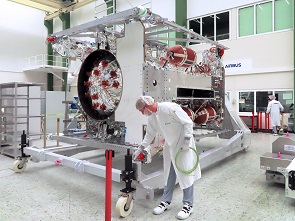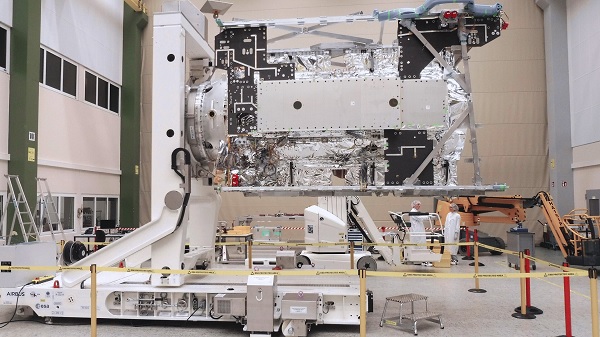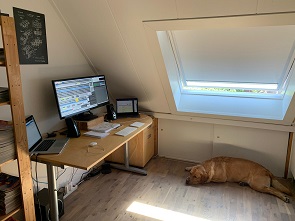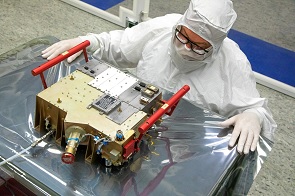#6: Start of assembly and integration for JUICE
26 June 2020
Despite certain operational difficulties caused by the COVID-19 pandemic, the assembly and integration of the flight model for ESA's JUpiter ICy moons Explorer (JUICE) spacecraft has continued with few delays during the first six months of the year.On 2 September 2019, the flight structure – the main skeleton of JUICE - was delivered to the Arianegroup facility in Lampoldshausen, Germany (see JUICE Journal #5).
Over the next seven months, technicians completed the integration of the chemical propulsion system: this included the large propellant tanks, the pressurant tanks, the main engine and the attitude control thrusters, together with all the pressure control and propellant distribution hardware, plus all the required piping and supports for thermal hardware and harness (electrical cables).
 |
| JUICE has arrived in Friedrichshafen for integration. Credit: Airbus |
In April 2020, after the acceptance testing of the propulsion system was successfully completed, the structure was loaded onto a special road transporter, for overnight delivery to the Airbus satellite integration centre facilities in Friedrichshafen, Germany.
The flight model of the spacecraft has now entered its assembly and integration phase. This involves integration of the harness, internal thermal blankets, and the remaining elements of the structure – large external panels and secondary structure brackets used to support different units.
This will be followed by the integration and testing of platform and internal electronic units of the payload. Next in line will be integration of external units such as antennas, deployable appendages and external payload units. The final stage of the assembly and integration process will be the closure of the structure and completion of its thermal protection hardware.
 |
| JUICE at Airbus in Friedrichshafen, for final integration. Credit: Airbus |
After this, the deployment of some of the appendages will be tested, and then the spacecraft will be transported to ESA's Space Technology and Research Centre (ESTEC) in the Netherlands at the beginning of 2021, where it will undergo its thermal balance / thermal vacuum test in the Large Space Simulator.
Meanwhile, parallel testing of the JUICE engineering model is ongoing at the Airbus facilities in Toulouse, France. So far, all of the engineering model instruments have been integrated and tested, as well as most of the platform units and subsystems, with completion expected by the end of this year.
Preparations for the system level test have also started, with the first closed loop test that will constitute the reference for the proto-flight model testing campaign. The engineering model will also receive the next computer software releases for pre-validation before they are loaded onto the flight model's onboard computer.
The first integrated ground/space functions test
The JUICE Space Operations team at ESOC in Darmstadt, Germany, has completed a major milestone by commanding for the first time the JUICE engineering model located in Toulouse, as ESA and Airbus engineers successfully conducted the first Integrated Ground/Space Functions Test (IGST) on 26 and 27 May.
The ESOC Mission Control System is the core ground infrastructure needed to command the spacecraft in orbit, while the JUICE engineering model is the functionally representative 3D prototype of the JUICE spacecraft, used for testing before the spacecraft flight model is built.
 |
| Testing JUICE from the home office. Credit: F. Torelli |
This was the first in a series of end-to-end tests in which the spacecraft is commanded in a manner equivalent to the way it will be done in flight.
The test was possible thanks to intensive preparation activities performed by ESOC personnel, the project team, and Airbus, including the development of the ground systems, the validation of the Flight Operational Procedures and the installation of the Network Data Interface Unit between the facilities in Darmstadt and Toulouse.
Even with the limitations caused by the COVID-19 pandemic, the test was performed as originally scheduled, with the core operations team at ESOC conducting the tests, Airbus test engineers in Toulouse checking the engineering model's status, and the project support team of ESA and Airbus engineers monitoring the operations from their home offices via remote desktop.
In this first test slot, several basic spacecraft functions were exercised, including two payload units: the magnetometer (J-MAG) and the High Accuracy Accelerometer (HAA) – the latter is part of the radio science experiment (3GM). The tests were successful and allowed the team to collect a number of important observations that will enable the refinement of the flight procedures.
This key milestone paves the way for more complex and intensive tests planned for the next IGST session in November 2020, and the System Validation Tests in 2021, when ESOC will interface with the JUICE spacecraft flight model.
The first science instrument delivery
The first of 10 flight model science instruments was delivered on schedule to Airbus in Friedrichshafen on 4 February 2020. Designed and built by Southwest Research Institute in San Antonio, Texas, the ultraviolet spectrograph (UVS) is NASA's main contribution to the mission.
 |
| First instrument delivered for Jupiter Icy Moons Explorer. Credit: SwRI |
The UVS instrument arrived before the flight model structure was available for integration, so technicians set up an "early bird" satellite on a table with the flight model on-board computer and connection unit. Testing was successfully completed and the instrument remains in a clean environment, where a continuous purging flow of nitrogen gas is maintained during the spacecraft integration sequence.
The JUICE Assembly, Integration and Test team is expecting the majority of the remaining flight model instruments units to be delivered before the thermal balance / thermal vacuum tests scheduled for January 2021.
Although the COVID-19 outbreak has affected the deployment of staff and the development of all instruments, some hardware tests for the J-MAG qualification model and the RPWI flight model could be carried out at ESA's ESTEC facilities. This was made possible via a remote link between the lab and the science team members, who were operating their respective instrument from their home premises.
"The remote testing went well, and no issues were detected," said Philippe Garé, ESA's JUICE payload manager. "Although the process would have been more efficient with the instrument team on site, we were able to keep within the schedule, despite COVID-19."
Meanwhile, engineering models of all 10 instruments were delivered to the Airbus facilities in Toulouse by the end of 2019. The instrument teams supported the integration of their hardware on the spacecraft engineering model structure, followed by the initial tests of the instruments and their compatibility with the spacecraft's software.
At present, six of the engineering model instruments have completed the planned second software update testing, with the remaining four scheduled to be tested by the end of July. A third and final test programme for the instruments' software will take place at the beginning of 2021.
About JUICE
JUICE – JUpiter ICy moons Explorer – is the first large-class mission in ESA's Cosmic Vision 2015-2025 programme. It will complete a unique tour of the Jupiter system that will include in-depth studies of three potentially ocean-bearing satellites, Ganymede, Europa and Callisto.
The Jupiter tour includes several flybys of each planet-sized world, culminating with orbit insertion around Ganymede, the largest moon in the Solar System, followed by nine months of operations in its orbit.
JUICE will carry the most powerful scientific payload ever flown to the outer Solar System. It consists of 10 state-of-the-art instruments plus one experiment that uses the spacecraft telecommunication system with ground-based instruments.
JUICE's instruments will enable scientists to compare each of these icy satellites and to investigate the potential for such bodies to harbour habitable environments such as subsurface oceans. They will also carry out observations of Jupiter, its atmosphere, magnetosphere, satellites and rings.







